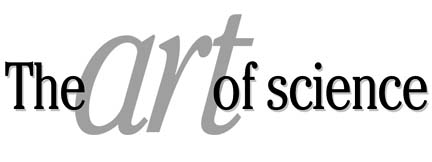
|

Creativity emerges when
subjects intersect in Nanakuli
Their lesson had spilled past its allotted 75 minutes and it was time to go home, but none of the fifth-graders budged.
"Every session is like that," said their teacher, Sonia Peralta, now in her 17th year at Nanaikapono Elementary School. "They really don't want to leave."
Her students are exploring the intersection of art and science in a classroom experiment sponsored by Bishop Museum. When Peralta was first offered the program, she wasn't sure how she would squeeze it into the school day.
Her school, nestled in Nanakuli Valley, is under the gun to get reading and math scores up to comply with the federal No Child Left Behind law, after missing targets for several years. Peralta has set aside long blocks of time daily for both subjects.
"I knew from the beginning it would be a valuable experience for the kids, but it was a question of how to juggle the day," she said. "I feel like I'm on a tightrope every day, trying to balance things.
"In the end it turned out to be a culminating project that incorporates all the content areas, and they're having fun doing it," she said. "I don't lose anything. Actually, the children are gaining a lot."

Native Hawaiian artist Solomon Enos demonstrates a new lesson for students. The new program by Bishop Museum is helping fifth-graders at Nanaikapono Elementary School in Nanakuli learn about the connections between science and art.
The pilot program will head to Waimanalo Elementary and Helemano School in Wahiawa next spring. The artists for those schools haven't been selected yet, and the programs will reflect their specialties, which could range from bronze sculpture to fiber art to wood carving.
At Nanaikapono, Peralta's class is focusing on two-dimensional art, drawing and painting fanciful creatures in various habitats where they face threats from man or nature. Each student researched the science of three different animals, studying their physical characteristics and habitats, before melding those traits to come up with a new animal.
Last week, they wrestled with how their creatures would overcome threats.
"This is when you guys can tell the story, instead of having the television tell them to you," Enos told them, with his irrepressible smile. "This is when you can use your ideas. Who needs TV anyway?"
Ultimately, the class will create a game together, featuring the 28 creatures they have designed on cards.
"How many of you have played Yu-Go-Ih?" asked Enos, prompting peals of laughter.
"Yu-Gi-Oh!" the students corrected him in chorus.
"Usually you have a winner and a loser," he went on, with a wink. "We're going to change that whole dynamic. Everyone who sits down to play this game needs to work together to stop the threat."
The goal of the game, Ali explained, is to create a balanced ecosystem. The rules will be up to the kids.

Kenneth Tanon quickly draws a pencil sketch of a new creature in between discussing the assignment with teachers and students.
"It really makes you want to do your research to figure it out," said 10-year-old Tyson Sugimoto. "It's really a lot of fun. I like this project because you can draw plenty. You get a reward for doing all your research, you get to draw and do this project."
His creature has owl wings, a mongoose head and turtle genes that allow it to drink sea water. The threat facing it is a "net monster," a shape-changer that can throw nets as traps.
Ali helps the students understand the ecology of their world. Enos opens their eyes to new artistic techniques, teaching them to capture perspective and create depth in their art, and how to work white paint into their brushes, for example, to highlight spots hit by the sun.
Most public elementary schools in Hawaii have no art teacher. The Artists in the Schools program, a collaboration with the Hawaii State Foundation for Culture and the Arts, allows students at some campuses to connect with professional artists.
This new "Science and Culture of Art" pilot project adds a different twist by incorporating science and bringing in Native Hawaiian role models for local youth. It is funded by the Hawaii State Foundation for Culture and the Arts and the federal Native Hawaiian Culture and Arts Program.
"It's fun because it teaches me about science and it helps me with my art," said Zak Kaohu, adding that Enos is "like more of a friend to me."
The pitched green roofs of Nanaikapono's brand-new campus echo the mountains that surround it, and that scenery carries over into the children's paintings. Halfway through the six-week program, the class has learned how both artists and scientists rely on observation, prediction and trial-and-error, and how they must have a deep knowledge of their materials and their settings.
"The ultimate goal is to inspire them in both art and science," said Kay Fullerton, science education manager at Bishop Museum.
Ali, who used to be a classroom teacher before joining the museum, said the subjects work well together, and the new approach is timely.
"There's so much emphasis on No Child Left Behind that reading and math are the focus, and art is usually the first thing that gets cut," Ali said. "By integrating the art and science together, it makes it a little bit easier for teachers to work it into the curriculum. It makes it so much more relevant for students, because they can see the connections and they can see a bigger picture."
[News] [Business] [Features] [Sports] [Editorial] [Do It Electric!]
[Classified Ads] [Search] [Subscribe] [Info] [Letter to Editor]
[Feedback]
